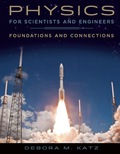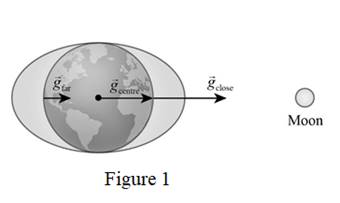
Concept explainers
(a)
Moon’s gravitational field at the side of Earth which is facing Moon.
(a)
Answer to Problem 55PQ
Moon’s gravitational field at the side of Earth facing Moon is
Explanation of Solution
Write the equation to find the gravitational field due to Moon at a distance of Moon-Earth distance minus radius of Earth.
Here,
Write the expression to find
Here,
Use the expression for
Conclusion
Substitute
Therefore, Moon’s gravitational field at the side of Earth facing Moon is
(b)
Moon’s gravitational field at the side of Earth facing away from Moon.
(b)
Answer to Problem 55PQ
Moon’s gravitational field at the side of Earth facing away from Moon is
Explanation of Solution
Write the equation to find the gravitational field due to Moon at a distance of Moon-Earth distance plus radius of Earth.
Write the expression for
Substitute the expression for
Conclusion:
Substitute
Therefore, Moon’s gravitational field at the side of Earth facing away Moon is
(c)
The gravitational field of Moon at the center of Earth.
(c)
Answer to Problem 55PQ
Moon’s gravitational field at the center of Earth is
Explanation of Solution
Write the equation to find the gravitational field due to Moon.
Conclusion:
Substitute
Therefore, Moon’s gravitational field at center of Earth is
(d)
Sketch Earth and include the three vectors from parts (a) through (c).
(d)
Answer to Problem 55PQ
Sketch of Earth and the three vectors from parts (a) through (c) is shown in Figure 1.
Explanation of Solution
Figure 1 shows the sketch of the Earth and the magnitude and direction of the gravitational field vectors found in part (a), (b) and (c).

Conclusion:
Therefore, Sketch of Earth and the three vectors from parts a through c is shown in Figure 1.
(e)
The reason why there are two tides a day on most places on Earth due to Moon.
(e)
Answer to Problem 55PQ
There are two tides a day on most places on Earth due to Moon because the force is larger on bodies of water closer to Moon and smaller on bodies of water on far side of Earth.
Explanation of Solution
Figure below shows the Earth and Moon. High tides and low tides on either side of Earth are due to the lunar activity on Earth. The gravitational pull by Moon on Earth causes high tide and low tide.

The force of Moon is large at water bodies which are close to Moon and lowest on water bodies which are far away. Thus the amplitude or strength of tides is dependent on the distance of the water body and Moon. This is the reason for two types of tides on Earth.
Conclusion:
Therefore, there are two tides a day on most places on Earth due to Moon because the force is larger on bodies of water closer to Moon and smaller on bodies of water on far side of Earth.
Want to see more full solutions like this?
Chapter 7 Solutions
Physics for Scientists and Engineers: Foundations and Connections
- Sketch a sine wave depicting 3 seconds of wave activity for a 5 Hz tone.arrow_forwardThe drawing shows two long, straight wires that are suspended from the ceiling. The mass per unit length of each wire is 0.050 kg/m. Each of the four strings suspending the wires has a length of 1.2 m. When the wires carry identical currents in opposite directions, the angle between the strings holding the two wires is 20°. (a) Draw the free-body diagram showing the forces that act on the right wire with respect to the x axis. Account for each of the strings separately. (b) What is the current in each wire? 1.2 m 20° I -20° 1.2 marrow_forwardplease solve thisarrow_forward
- please solve everything in detailarrow_forward6). What is the magnitude of the potential difference across the 20-02 resistor? 10 Ω 11 V - -Imm 20 Ω 10 Ω 5.00 10 Ω a. 3.2 V b. 7.8 V C. 11 V d. 5.0 V e. 8.6 Varrow_forward2). How much energy is stored in the 50-μF capacitor when Va - V₁ = 22V? 25 µF b 25 µF 50 µFarrow_forward
- 9). A series RC circuit has a time constant of 1.0 s. The battery has a voltage of 50 V and the maximum current just after closing the switch is 500 mA. The capacitor is initially uncharged. What is the charge on the capacitor 2.0 s after the switch is closed? R 50 V a. 0.43 C b. 0 66 C c. 0.86 C d. 0.99 C Carrow_forward1). Determine the equivalent capacitance of the combination shown when C = 12 pF. +11/20 2C C Carrow_forward3). When a capacitor has a charge of magnitude 80 μC on each plate the potential difference across the plates is 16 V. How much energy is stored in this capacitor when the potential difference across its plates is 42 V? a. 1.0 mJ b. 4.4 mJ c. 3.2 mJ d. 1.4 mJ e. 1.7 mJarrow_forward
- 5). A conductor of radius r, length & and resistivity p has resistance R. It is melted down and formed into a new conductor, also cylindrical, with one fourth the length of the original conductor. The resistance of the new conductor is a. 1 R 161 b. 1 R C. R d. 4R e. 16Rarrow_forward8). Determine the magnitude and sense (direction) of the current in the 10-Q2 resistor when I = 1.8 A. 30 V L 50 V 10 Ω 20 Ω a. 1.6 A right to left b. 1.6 A left to right C. 1.2 A right to left d. 1.2 A left to right e. 1.8 A left to right R PGarrow_forward7). Determine the current in the 10-V emf. 5.0 0 w 10 V 5.0 0 15 V 5.0 Ω a. 2.3 A b. 2.7 A c. 1.3 A d. 0.30 A e. 2.5 Aarrow_forward
 Physics for Scientists and Engineers: Foundations...PhysicsISBN:9781133939146Author:Katz, Debora M.Publisher:Cengage Learning
Physics for Scientists and Engineers: Foundations...PhysicsISBN:9781133939146Author:Katz, Debora M.Publisher:Cengage Learning Principles of Physics: A Calculus-Based TextPhysicsISBN:9781133104261Author:Raymond A. Serway, John W. JewettPublisher:Cengage Learning
Principles of Physics: A Calculus-Based TextPhysicsISBN:9781133104261Author:Raymond A. Serway, John W. JewettPublisher:Cengage Learning Physics for Scientists and EngineersPhysicsISBN:9781337553278Author:Raymond A. Serway, John W. JewettPublisher:Cengage Learning
Physics for Scientists and EngineersPhysicsISBN:9781337553278Author:Raymond A. Serway, John W. JewettPublisher:Cengage Learning Physics for Scientists and Engineers with Modern ...PhysicsISBN:9781337553292Author:Raymond A. Serway, John W. JewettPublisher:Cengage Learning
Physics for Scientists and Engineers with Modern ...PhysicsISBN:9781337553292Author:Raymond A. Serway, John W. JewettPublisher:Cengage Learning Physics for Scientists and Engineers, Technology ...PhysicsISBN:9781305116399Author:Raymond A. Serway, John W. JewettPublisher:Cengage Learning
Physics for Scientists and Engineers, Technology ...PhysicsISBN:9781305116399Author:Raymond A. Serway, John W. JewettPublisher:Cengage Learning Glencoe Physics: Principles and Problems, Student...PhysicsISBN:9780078807213Author:Paul W. ZitzewitzPublisher:Glencoe/McGraw-Hill
Glencoe Physics: Principles and Problems, Student...PhysicsISBN:9780078807213Author:Paul W. ZitzewitzPublisher:Glencoe/McGraw-Hill





